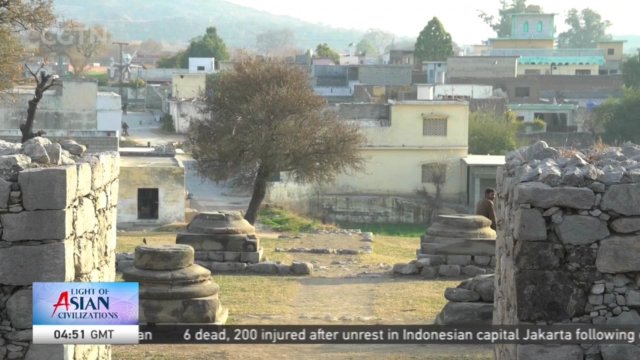
13:28, 22-May-2019
Exploring Pakistan's Taxila: Archeological site was at junction of three major trade routes
Updated
13:20, 25-May-2019
03:08

It's time for our special series on Asian civilizations. Today is the last day of the week-long gathering on the Dialogue of Asian Civilizations in Beijing.
Today we head to Pakistan, Taxila is an important archaeological site in northern Pakistan. It's located at the junction of three major ancient trade routes. Our correspondent Danial Khan takes a walk in the lonely streets of the
once thriving town.
Pakistan is known as the cradle of Buddhism and the hub of Gandhara school of sculpture, a treasure-trove of arts and crafts. The town of Taxila was once the spiritual and cultural hotspot of one of the earliest civilizations of the world - Buddhism.
GHULAM RASOOL CARETAKER, MOHRA MORADO STUPA, TAXILA "Buddha was born in the year 563 BC and died in 480 BC in Lumbini, he could only reach India, and in Kushinara a stupa was built at the place of his death. But many of his followers came here to Taxila."
In 327 B.C. Alexander the Great conquered Taxila, and later, it came under the Mauryan dynasty and reached a great level of development under the rule of Asoka. The next period in Taxila's history was that of the Indo-Greek descendants of Alexander's warriors. And the final era is known as The Gandhara period. The great Kushan Dynasty was then established in 50 AD, and during these 200 years, Taxila became the most renowned centre for philosophy, art, and learning, before it was vandalized beyond repair.
GHULAM RASOOL CARETAKER, MOHRA MORADO STUPA, TAXILA "In the 5th century, this place was completely destroyed by the Huns, and later it was devastated by earthquakes, and it was only in 1915 that the city was discovered by a Britisher named John Marshall."
DANIAL KHAN TAXILA "Built in 1928, the museum is home to a significant and comprehensive collection of Gandhara art, dating from the 1st to the 7th centuries, most pieces in the collection here were excavated from the ruins of ancient Taxila."
There are many images of Buddha and numerous panels describing the important stages of his life. The historical sites at Taxila are being maintained to protect and preserve it from any changes to its authenticity. Attention is being paid in conservation plans to maintain original designs, traditions, techniques, locations, and settings. Taxila became a protected antiquity after a law was passed in 1975 by the government of Pakistan, and later it was designated a UNESCO World Heritage site in the year 1980. Danial Khan, CGTN, Taxila.

SITEMAP
Copyright © 2018 CGTN. Beijing ICP prepared NO.16065310-3
Copyright © 2018 CGTN. Beijing ICP prepared NO.16065310-3